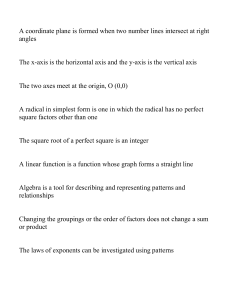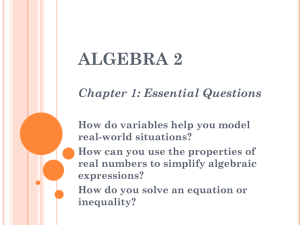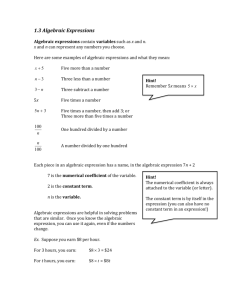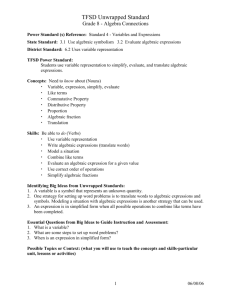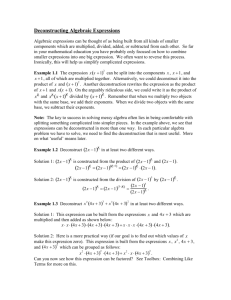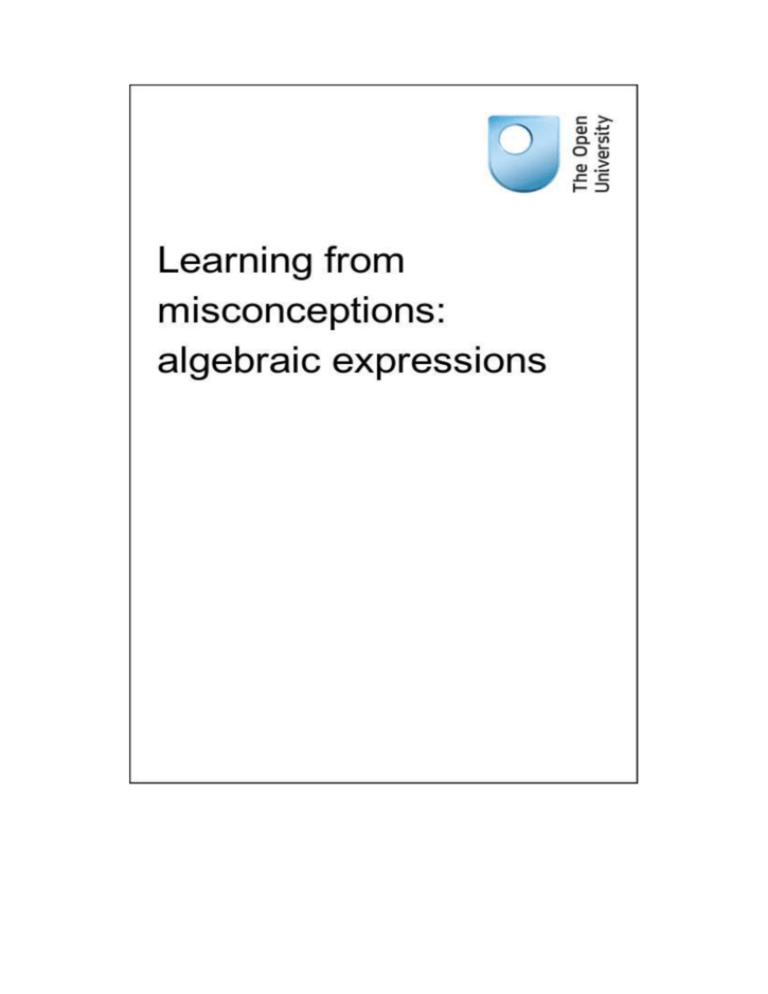
Learning from misconceptions: algebraic expressions TI-AIE
TI-AIE Secondary Maths
TI-AIE
Learning from misconceptions:
algebraic expressions
Page 2 of 22
http://www.open.edu/openlearnworks/course/view.php?id=1911
27th May 2015
Learning from misconceptions: algebraic expressions TI-AIE
This publication forms part of the Open University module [module code and title].
[The complete list of texts which make up this module can be found at the back
(where applicable)]. Details of this and other Open University modules can be
obtained from the Student Registration and Enquiry Service, The Open University,
PO Box 197, Milton Keynes MK7 6BJ, United Kingdom (tel. +44 (0)845 300 60 90;
email general-enquiries@open.ac.uk).
Alternatively, you may visit the Open University website at www.open.ac.uk where
you can learn more about the wide range of modules and packs offered at all levels by
The Open University.
To purchase a selection of Open University materials visit www.ouw.co.uk, or contact
Open University Worldwide, Walton Hall, Milton Keynes MK7 6AA, United
Kingdom for a catalogue (tel. +44 (0) 1908 274066; fax +44 (0)1908 858787; email
ouw-customer-services@open.ac.uk).
The Open University,
Walton Hall, Milton Keynes
MK7 6AA
First published 200X. [Second edition 200Y. Third edition ....] [Reprinted 200Z]
Copyright © 200X, 200Y The Open University
All rights reserved. No part of this publication may be reproduced, stored in a
retrieval system, transmitted or utilised in any form or by any means, electronic,
mechanical, photocopying, recording or otherwise, without written permission from
the publisher or a licence from the Copyright Licensing Agency Ltd. Details of such
licences (for reprographic reproduction) may be obtained from the Copyright
Licensing Agency Ltd, Saffron House, 6–10 Kirby Street, London EC1N 8TS
(website www.cla.co.uk).
Open University materials may also be made available in electronic formats for use
by students of the University. All rights, including copyright and related rights and
database rights, in electronic materials and their contents are owned by or licensed to
The Open University, or otherwise used by The Open University as permitted by
applicable law.
In using electronic materials and their contents you agree that your use will be solely
for the purposes of following an Open University course of study or otherwise as
licensed by The Open University or its assigns.
Except as permitted above you undertake not to copy, store in any medium (including
electronic storage or use in a website), distribute, transmit or retransmit, broadcast,
modify or show in public such electronic materials in whole or in part without the
prior written consent of The Open University or in accordance with the Copyright,
Designs and Patents Act 1988.
Page 3 of 22
http://www.open.edu/openlearnworks/course/view.php?id=1911
27th May 2015
Learning from misconceptions: algebraic expressions TI-AIE
Edited and designed by The Open University.
Printed and bound in the United Kingdom by [name and address of printer].
ISBN XXX X XXXX XXXX X
X.X
Page 4 of 22
http://www.open.edu/openlearnworks/course/view.php?id=1911
27th May 2015
Learning from misconceptions: algebraic expressions TI-AIE
Contents
What this unit is about
What you can learn in this unit
1 Variables and constants in a real-life context
2 Using substitution to think about possibilities
3 Using generalisation to find misconceptions
4 Summary
Resources
Resource 1: NCF/NCFTE teaching requirements
Additional resources
References
Acknowledgements
Page 5 of 22
http://www.open.edu/openlearnworks/course/view.php?id=1911
27th May 2015
Learning from misconceptions: algebraic expressions TI-AIE
What this unit is about
Algebraic expressions are mathematical sentences such as 3x + 4. They do not have
an equals sign (=), which makes them different from algebraic equations. Algebraic
expressions play an important role in the mathematics curriculum and in mathematics
in general. In order to progress and do well in mathematics, students need to be able
to read and write expressions, and to be skilled in computations and manipulations of
algebraic expressions.
For many students the issue with learning about algebraic expressions is that the work
is purely a question of memorising and following algorithms. The power and beauty
of algebra to express generality, describe relationships between variables and
constants, and explore possibilities in a playful and creative way, is often lost.
Algebra and its expressions are considered as the language of mathematics, and are
used to describe relationships between people, thoughts, elements and structures.
Students often do not experience this in their learning at school and thus cannot see
the purpose of learning about algebraic expressions and how they relate to real life,
apart from passing mathematics examinations.
This unit will explore some different approaches to teaching algebraic expressions by
using and developing contexts to help students see the purpose in algebraic
expressions. It will first explore the role of variables and constants in a real-life
context; it will then look at the power of substitution and how this can stimulate
thinking creatively and learning from misconceptions.
Pause for thought
Think of your own classroom. What do you think are the issues for your students
when learning about algebraic expressions? What do you think they like about it?
What do they dislike? What do you think they would like to be different?
Then think back to when you were learning about algebraic expressions in school –
how did you feel? What about it did you like? What about it did you dislike? What
would you have liked to be different?
Page 6 of 22
http://www.open.edu/openlearnworks/course/view.php?id=1911
27th May 2015
Learning from misconceptions: algebraic expressions TI-AIE
What you can learn in this unit
How to help students to identify relations between variables and
constants.
Some ideas on using and developing contexts to help students see the
purpose in algebraic expressions.
Some ideas on eliciting misconceptions and using them as a learning
tool.
The learning in this unit links to the NCF (2005) and NCFTE (2009) teaching
requirements in Resource 1.
Page 7 of 22
http://www.open.edu/openlearnworks/course/view.php?id=1911
27th May 2015
Learning from misconceptions: algebraic expressions TI-AIE
1 Variables and constants in a real-life context
Nehru Place in Delhi, Asia’s largest market for computers and peripherals, can always
become crowded. During business hours there is an extremely dynamic atmosphere.
Everything from a hawker to the car park or the number of staff required in a shop is
affected by how fast the environment changes from morning to evening (Figure 1).
This change in an environment is called dynamics.
Figure 1 Dynamics in real life: Nehru Place, Delhi, when it is quiet (left) and busy (right).
Professional mathematicians develop models to predict and describe these dynamics.
In doing so they make it possible for urban planners, local policy makers and law
enforcers to foresee what might be needed at different times in terms of labour,
provisions, support structures, and so on.
This mathematical modelling relies on deciding what the variables (the numerical
quantities that will vary) and the constants are (the quantities that will stay the same)
in this setting. Activity 1 introduces a way to teach this with your students using an
example from city life. (If your students are unfamiliar with Nehru Place or a similar
environment, you could amend this example for a context they know.) The next step
is to decide which variables are connected and in what way, and Activity 2 gives you
an idea for how to do this with your students.
In Activities 1 and 2, you and your students will think about how to make a simplified
version of such a model; note that there is no single right or wrong answer. These
tasks work particularly well for students working in pairs or small groups, because
this allows more ideas to be generated and students can offer mutual support when
stuck.
Before attempting to use the activities in this unit with your students, it would be a
good idea to complete all (or at least part) of the activities yourself. It would be even
better if you could try them out with a colleague, as that will help you when you
reflect on the experience. Trying the activities yourself will mean that you get insights
into learners’ experiences that can in turn influence your teaching and your
experiences as a teacher. When you are ready, use the activities with your students.
After the lesson, think about the way that the activity went and the learning that
happened. This will help you to develop a more learner-focused teaching
environment.
Page 8 of 22
http://www.open.edu/openlearnworks/course/view.php?id=1911
27th May 2015
Learning from misconceptions: algebraic expressions TI-AIE
Activity 1: Identifying constants and variables
Tell your students the following:
Imagine you are a professional mathematician and you are working on
developing a mathematical model to describe the dynamics of Nehru
Place in Delhi. You first have to identify all the variables (quantities
that vary) and constants (quantities that stay the same) playing a role
in Nehru Place.
Make a list of all the ‘players’ or ‘elements’ in this setting. Some
examples could bethe car park, the hawkers or the number of shops
on the first floor.
When your students have generated some ideas write the list below on the board:
The number of:
police men and women who work at the police
department in charge of security at the complex
car parks
people employed by the municipal corporation that is
in charge of civic maintenance of the complex
parking lot attendants
hawkers
escalators
shop owners whose shop is on the first floor
restaurant owners on the ground floor
electricity supply companies
visitors wanting to purchase a laptop.
Then tell your students:
On this list are some more examples of ‘players’ or ‘elements’ in this context.
Between this list and your own examples, decide which are variables (with quantities
that vary) and which are constants (with quantities that stay the same). Will any of
these be both? If so, what would this depend on?
Activity 1 asked the students to identify variables and constants in Nehru Place. To
develop a mathematical model, the students now need to think how these constants
and variables influence and relate to each other.
The activity asks the students to make a mind map. A mind map is typically a series
of words or phrases to represent the concept (as a node), and a line (or link) joining it
to another concept, expressing a relationship of the two. A concept map is similar to a
mind map, except mind maps have a centre whereas concept maps can be linear. The
mind map is a good tool and provides an effective strategy to help the students
explore and review their own understanding; it can also be used as an assessment tool
Page 9 of 22
http://www.open.edu/openlearnworks/course/view.php?id=1911
27th May 2015
Learning from misconceptions: algebraic expressions TI-AIE
to find out what the students know and what their misconceptions are. There are no
right or wrong answers in Activity 2.
Activity 2: Developing algebraic expressions
With your students, imagine again that you are professional mathematicians working
on developing a mathematical model to describe the dynamics of Nehru Place in
Delhi. You have already identified the variables (with quantities that vary) and
constants (with quantities that stay the same) that play a role in Nehru Place.
The next step is to identify how the variables relate to each other and to the constants.
To keep it manageable, each group of students should decide which four variables
they will focus on. Now tell your students the following:
Make a mind map of these variables and write on the lines connecting
the ideas how you think they might relate. Add some constants to the
mind map if you think they play a role in the relationship. Remember
there are no right or wrong answers for this! For example, you could
think that the number of police officers should vary depending on
how many visitors (buyers) there are at any given time, or on the
number of shops or cars.
Now decide which quantifiers you would use in the relationships your
group described above. Write these as a mathematical expression. For
example, you could state that you would need one police officer for a
combination of every ten shops, 100 visitors or 50 cars; in which case
you could write a model of the number of police officers like this:
s/10 + v/100 + c/50. Remember there is no right or wrong answer!
When the students have generated some mathematical expressions, move them into
thinking out possible outcomes for their modelling. Tell them to do the following:
Predict the range of values for each variable. In cases where you are
having difficulty predicting a range, identify the reasons for the
difficulty. For example, the number of escalators cannot be less than
one, because you cannot have half of an escalator. You also cannot
have an unlimited number of escalators, because they take up space.
Deciding on the maximum number of escalators is harder to do
because it will depend on several factors.
Decide which of the variables you think can be controlled easily?
Controlling a variable could mean either that its range can be
restricted or that its value can be fixed without affecting the situation
very much.
At the end of the activity, ask the whole class to discuss this point: in
reality, the quantifiers used in modelling will be based on data. If you
had to organise this, how could you collect the information?
Case Study 1: Mrs Aparajeeta reflects on using Activities 1
Page 10 of 22
http://www.open.edu/openlearnworks/course/view.php?id=1911
27th May 2015
Learning from misconceptions: algebraic expressions TI-AIE
This is the account of a teacher who tried Activities 1 and 2 with her secondary
students.
I wanted to do these activities with my students because I thought it was a lovely
example of seeing and recognising mathematics in real life. We first thought of a few
examples with the whole class. Straight away I asked them to sort these into variables
and constants. This early discussion made them aware that this was not always easy to
determine. For example, the number of car parks might be considered constants;
however, if you looked at the situation over a longer time period – for example, two
years – then it could become a variable because, in theory, more car parks could be
built in that time if there was the space and the money.
They worked in pairs on finding more examples and thinking of reasons why and
when the example was a variable or a constant. Their examples and classifications
were all recorded on the blackboard. These were then used to work on Activity 2:
thinking about how they relate to each other and how to record this mathematically by
writing it as expressions and deciding on coefficients. A student said that she had
never considered coefficients to indicate a proportion and that she now suddenly
understood why there are these rules when working with expressions.
At first the students felt uncomfortable with the idea that there could be no right or
wrong answers. However, after sharing some ideas about the possible expressions
involving the same variables and constants, they could see why this was so and
became more creative with their answers.
Because I really wanted these activities to make the students see and recognise
mathematics in real life, as homework I asked them to do the same for a different
situation they would encounter that night. For example, to identify variables and
constants and how they related while waiting at the bus stop, having dinner with their
families or doing their homework.
Reflecting on your teaching practice
When you do such an exercise with your class, reflect afterwards on what went well
and what went less well. Consider the questions that led to the students being
interested and being able to get on, and those where you needed to clarify. Such
reflection always helps with finding a ‘script’ that helps you engage the students to
find mathematics interesting and enjoyable. If they do not understand and cannot do
something, they are less likely to become involved. Use this reflective exercise every
time you undertake the activities, noting, as Mrs Aparajeeta did, some quite small
things that made a difference.
Page 11 of 22
http://www.open.edu/openlearnworks/course/view.php?id=1911
27th May 2015
Learning from misconceptions: algebraic expressions TI-AIE
Pause for thought
Good questions to trigger reflection are:
How did it go with your class? Did all the students participate?
What responses from students were unexpected? Why?
What questions did you use to probe your students’ understanding?
Did you feel you had to intervene at any point?
What points did you feel you had to reinforce?
Did you modify the task in any way? If so, what was your reasoning
for this?
Page 12 of 22
http://www.open.edu/openlearnworks/course/view.php?id=1911
27th May 2015
Learning from misconceptions: algebraic expressions TI-AIE
2 Using substitution to think about possibilities
Substitution is a powerful and necessary thinking tool. In real life, substitution is used
constantly: for example, deciding which different herbs and spices to use in today’s
meal to make it different from yesterday’s; which mode of transport to use (will you
walk, or take a rickshaw or bus?), or which sari to wear. Substitution involves
thinking about possibilities and alternatives whilst also considering limitations. For
example, substituting a silk sari for a calculator will not be very valid when the aim is
to change your dress, but could be valid when considering what you are going to
spend your money on. Substitution thus allows for variation – the spice of life.
The thinking process of substitution in mathematics is similar to that in real life. It
involves considering examples, alternatives and possibilities, while at the same time
being aware of limitations and restrictions.
Pause for thought
In what way do you think is mathematical substitution is different or
similar to substitution in real life?
Why would you spend time in class working on substitution?
Learning opportunities when working on
substitution
For their studies in mathematics, students have to learn the skill of substitution –
many exercises and problems in exercise books and examination require students to
demonstrate this skill.
Giving students problems to solve that involve substitution also offers other
opportunities for learning mathematics that are perhaps not so obvious but which are
equally important and worthwhile. Some of these, which will be explored further, are:
Substitution as a tool to make mathematical expressions come alive by
making a story of what an algebraic expression can mean. Activity 3
is an example of this.
Substitution as a tool to generalise a specific numerical example.
Activity 4 is an example of this.
Substitution to explore mathematical relationships, properties and
limits. Activity 4 has some examples of this.
Page 13 of 22
http://www.open.edu/openlearnworks/course/view.php?id=1911
27th May 2015
Learning from misconceptions: algebraic expressions TI-AIE
Using substitution to develop imagination
Algebra and its expressions are often considered to be the language of mathematics
because they describe relationships. When doing page after page of practice from the
textbook on manipulating algebraic expressions, students might be forgiven for not
recognising this as eloquent language!
The next activity aims to introduce some playfulness in reading algebraic expressions
and asks students to come up with their own stories of what the expression might
mean and what situation it models. This means that the students are asked to give
meaning to the symbolised mathematics by substituting the symbols with a narrative
or story. For example:
The expression + 3n could be about a group of people (x) who in
equal numbers boarded a number of buses (n). There were some
people who arrived late and each bus had to accommodate another
three people.
The expression 1.3(2100m) could have come from the expression 1.3
[3(700)m] and be about 700 space aliens who landed in Udaipur. This
was their first time in India. They saw that people seemed to like a
drink called chai which cost Rs. 1 per cup. They tried it, and loved it
so much that they had three cups each. When they wanted to pay for
the tea they were so pleased with the quality of the chai and the
service they had received that they paid a tip of 30 per cent.
Activity 3: What could it mean?
Tell your students the following.
Below are some algebraic expressions adapted from textbooks:
30u + 44v
3x +1
Use your imagination and make up a story for what each expression could be about.
What situation could the expression be modelling? What else could it be about?
Page 14 of 22
http://www.open.edu/openlearnworks/course/view.php?id=1911
27th May 2015
Learning from misconceptions: algebraic expressions TI-AIE
Video: Storytelling, songs, role play and drama
You may also want to have a look at the key resource ‘Storytelling, songs, role play
and drama’.
Case Study 2: Mrs Kapur reflects on using Activity 3
Thinking of an actual story to fit an expression was not something I myself found
easy. But I found that the examples given about the people on the bus and the aliens
drinking copious amounts of chai tea really helped me and made me think more freely
and creatively of other examples. I decided that because this had worked well for me,
I would give it a go and use the same approach with my students. So I started the
activity by writing the expressions for the bus and alien stories on the blackboard,
giving them a few moments (not too long) to think of a story and then sharing it with
the class.
I then wrote the expressions of Activity 3 on the blackboard. Rahul immediately
thought that the expression 3x + 1 could tell the story of how much it cost to make
three cups of tea: x rupees for the water and tea, and a fixed cost of 1 rupee for
something. Some students agreed and others did not, but an interesting discussion
followed. It made me realise that working from a somewhat imperfect example is
actually more effective in generating discussion than having a perfectly correct
answers.
Pause for thought
What questions did you use to probe your students’ understanding?
Did you modify the task in any way like Mrs Kapur did? If so, what
was your reasoning for this?
Page 15 of 22
http://www.open.edu/openlearnworks/course/view.php?id=1911
27th May 2015
Learning from misconceptions: algebraic expressions TI-AIE
3 Using generalisation to find misconceptions
When you see an expression like 2(3 – 8), you might spot immediately that this could
be rewritten as
(2 × 3) – (2 × 8), because it is an example of the law of distributivity where a(b – c) =
a × b – a × c.
Spotting such patterns and generalisations is helpful in mathematics because it makes
it easier to solve problems. The downside is that sometimes you might think
something is a pattern and so you generalise it, when actually it is a special case and
will only be true in some circumstances. The next activity gives some examples of
writing generalised algebra from numerical expressions.
Activity 4: Substituting the specific with the generalised form
Tell your students the following:
Below are expressions and equations that are arithmetic examples of a
generalised form that algebraic expressions and equations can take.
Some of these are equations, not just expressions – make sure you
know the difference.
1. 2 (3 – 8)
2. 12 + (13 + 81) = (12 + 13) + 81
3. 2 + 2 = 2 × 2
4. (–7) = 7
5. 42 + 0 = 42
6. 23 × 1 = 23
7. 5 per cent of 120
8. (12 + 51)/(12 × 51)
9. 2 + 3 = 3 + 2
10.
Write down general algebraic expressions or equations for these.
There is more than one solution for some of them, so be inventive!
Will these always hold true? Can you say that they will be valid for
any number?
Video: Monitoring and giving feedback
Page 16 of 22
http://www.open.edu/openlearnworks/course/view.php?id=1911
27th May 2015
Learning from misconceptions: algebraic expressions TI-AIE
You may also want to have a look at the key resource ‘Monitoring and giving
feedback’.
Case Study 3: Mrs Agarwal reflects on using Activity 4
Mohit spotted straight away that the first expression, 2 (3 – 8), was an example of the
distributive property over subtraction, and according to him it would hold for any
value of number. He gave the general form as a(b – c) = a × b – a × c.
The example of 2 + 2 = 2 × 2 led to interesting discussions and made some
misconceptions come to the fore about indices and what ‘to the power of’ means
when Rima said that ‘= 22’ could be added to that equation. Questions 6 and 7 made
the students think about identities and some were surprised that these were not the
same for all operations – they actually knew this when working with arithmetic
examples, but seemed to have forgotten when using a generalised form!
Although I was happy to try out this task, I had not expected that it would offer me so
many insights into students’ misconceptions. I am still thinking about why this
activity lets this happen. Was it the discussion, or the ‘simple’ examples? Why does it
not happen so much when doing exercises from textbooks? When I am thinking about
ways that I assess my students in class, I must remember that using tasks that ask the
students to apply what they know in an unusual but not necessarily difficult context
lets me evaluate what they know very clearly.
Pause for thought
What responses from students were unexpected? Why?
What questions did you use to probe your students’ understanding?
What do you think is the reason that this task allows misconceptions
to emerge as they did in Mrs Agarwal’s class?
Page 17 of 22
http://www.open.edu/openlearnworks/course/view.php?id=1911
27th May 2015
Learning from misconceptions: algebraic expressions TI-AIE
4 Summary
This unit has asked you to think about writing and working with algebraic
expressions. The activities have introduced ideas that are used extensively in the real
world to model complex situations and allow decisions to be made. Asking the
students to come up with mathematical expressions for themselves for a situation of
their choosing helps to get away from mundane practice in using expressions and to
help them see that these things are important. It is much easier to use the
mathematical language of expressions to communicate some ideas, but this is
something that students are rarely exposed to.
The final activities asked the students to discuss ideas about expressions in a relaxed
way so that misconceptions can be uncovered and dealt with. The focus on
generalising – that is, being sure that the equivalence in expressions is always true –
helped them to connect naturally to many other ideas in algebra.
Pause for thought
Identify three ideas that you have used in this unit that would work when teaching
other topics. Make a note of two topics you have to teach soon where those ideas can
be used with some small adjustments.
Page 18 of 22
http://www.open.edu/openlearnworks/course/view.php?id=1911
27th May 2015
Learning from misconceptions: algebraic expressions TI-AIE
Resources
Resource 1: NCF/NCFTE teaching requirements
This unit links to the following teaching requirements of the NCF (2005) and NCFTE
(2009), and will help you to meet those requirements:
View students as active participants in their own learning and not as
mere recipients of knowledge; to encourage their capacity to
construct knowledge; to ensure that learning shifts away from rote
methods.
View learning as a search for meaning out of personal experiences and
knowledge generation as a continuously evolving process of
reflective learning.
Help students to see mathematics as something to talk about, to
communicate through, to discuss among themselves, to work together
on.
Connect school knowledge with community knowledge and life
outside the school.
Page 19 of 22
http://www.open.edu/openlearnworks/course/view.php?id=1911
27th May 2015
Learning from misconceptions: algebraic expressions TI-AIE
Additional resources
A newly developed maths portal by the Karnataka government:
http://karnatakaeducation.org.in/KOER/en/index.php/Portal:Mathema
tics
Class X maths study material:
http://www.zietmysore.org/stud_mats/X/maths.pdf
National Centre for Excellence in the Teaching of Mathematics:
https://www.ncetm.org.uk/
National STEM Centre: http://www.nationalstemcentre.org.uk/
OpenLearn: http://www.open.edu/openlearn/
BBC Bitesize: http://www.bbc.co.uk/bitesize/
Khan Academy’s math section: https://www.khanacademy.org/math
NRICH: http://nrich.maths.org/frontpage
Mathcelebration: http://www.mathcelebration.com/
Art of Problem Solving’s resources page:
http://www.artofproblemsolving.com/Resources/index.php
Teachnology: http://www.teach-nology.com/worksheets/math/
Maths is Fun: http://www.mathsisfun.com/
National Council of Educational Research and Training’s textbooks
for teaching mathematics and for teacher training of mathematics:
http://www.ncert.nic.in/ncerts/textbook/textbook.htm
AMT-01 Aspects of Teaching Primary School Mathematics, Block 3
(‘Numbers (II)’): http://www.ignou4ublog.com/2013/06/ignou-amt01-study-materialbooks.html
LMT-01 Learning Mathematics, Block 1 (‘Approaches to Learning’)
Block 2 (‘Encouraging Learning in the Classroom’), Block 6
(‘Thinking Mathematically’):
http://www.ignou4ublog.com/2013/06/ignou-lmt-01-studymaterialbooks.html
Learning Curve and At Right Angles, periodicals about mathematics
and its teaching:
http://azimpremjifoundation.org/Foundation_Publications
Central Board of Secondary Education’s books and support material
(also including the Teachers Manual for Formative Assessment –
Mathematics (Class IX)) – select ‘CBSE publications’, then ‘Books
and support material’: http://cbse.nic.in/welcome.htm
Page 20 of 22
http://www.open.edu/openlearnworks/course/view.php?id=1911
27th May 2015
Learning from misconceptions: algebraic expressions TI-AIE
References
Bell, A. (1986) ‘Diagnostic teaching: 2 – Developing conflict-discussion lessons’,
Mathematics Teaching, vol. 116, pp.26–9.
Bell, A. (1987) ‘Diagnostic teaching: 3 – Provoking discussion’, Mathematics
Teaching, vol. 118, pp. 21–3.
Skemp, R. (1976) ‘Relational understanding and instrumental understanding’,
Mathematics Teaching, vol. 77, pp. 20–26.
Egan, K. (1986) Teaching as Story Telling: An Alternative Approach to Teaching and
Curriculum in the Elementary School. Chicago, IL: University of Chicago Press.
National Council of Educational Research and Training (2005) National Curriculum
Framework (NCF). New Delhi: NCERT.
National Council of Educational Research and Training (2009) National Curriculum
Framework for Teacher Education (NCFTE). New Delhi: NCERT.
National Council of Educational Research and Training (2012a) Mathematics
Textbook for Class IX. New Delhi: NCERT.
National Council of Educational Research and Training (2012b) Mathematics
Textbook for Class X. New Delhi: NCERT.
Watson, A., Jones, K. and Pratt, D. (2013) Key Ideas in Teaching Mathematics.
Oxford: Oxford University Press.
Page 21 of 22
http://www.open.edu/openlearnworks/course/view.php?id=1911
27th May 2015
Learning from misconceptions: algebraic expressions TI-AIE
Acknowledgements
Except for third party materials and otherwise stated below, this content is made
available under a Creative Commons Attribution-ShareAlike licence
(http://creativecommons.org/licenses/by-sa/3.0/). The material acknowledged below is
Proprietary and used under licence for this project, and not subject to the Creative
Commons Licence. This means that this material may only be used unadapted within
the TESS-India project and not in any subsequent OER versions. This includes the use
of the TESS-India, OU and UKAID logos.
Grateful acknowledgement is made to the following sources for permission to
reproduce the material in this unit:
Figure 1: left, image from http://officespaceinjasola.blogspot.co.uk/2011/02/; right,
image from http://prayfordelhi.blogspot.co.uk/
Every effort has been made to contact copyright owners. If any have been
inadvertently overlooked the publishers will be pleased to make the necessary
arrangements at the first opportunity.
Video (including video stills): thanks are extended to the teacher educators,
headteachers, teachers and students across India who worked with The Open
University in the productions.
Page 22 of 22
http://www.open.edu/openlearnworks/course/view.php?id=1911
27th May 2015



